In the fold: Issey Miyake, Ikko Tanaka, and the art of fashion
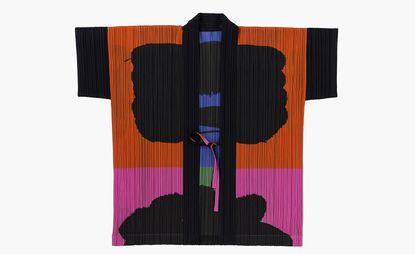
As the distinction between fashion, graphic design and art becomes ever more blurred, Issey Miyake’s latest collaborative offering revels in such indistinction. His new micro-collection is emblazoned with the graphic artwork of Ikko Tanaka, a keystone of 20th century Japanese art. Tanaka’s deceptively simple oeuvre uses block colours and overlaid geometric forms to explore the boundaries of abstraction and realistic portraiture. Once art, now clothing, Miyake revitalises Tanaka’s legacy in this new series of dresses, coats and bags.
Miyake and Tanaka were acquainted, and held each other’s work in high regard. They met in the sixties and maintained a close friendship until Tanaka’s death in 2002. Just over a decade after his passing, Miyake’s reinterpretation of his work is a timely homage, from one Japanese icon to another.
Tanaka’s tome Variations of Bold Symbols (1992) is a mosaic of colour blocks adorned with hand-drawn symbols. It vividly celebrates abstraction and eschews any recognisable human form. His work for the 200th anniversary of the artist Tōshūsai Sharaku’s birth, however, layers circular forms into the shape of a peeping face, a traditional form of portraiture known as Okubi-e for which Sharaku earned his fame. His most famous work, Nihon Buyo (1981), blends these two modes of creation, tessellating stark geometric shapes into the abstract form of a geisha.
While Tanaka’s designs are now most commonly reproduced on posters or in books on Japanese art, Miyake’s creations seek to recontextualise his work, introducing the dynamism of the body to the vitality of the artist’s aesthetic.
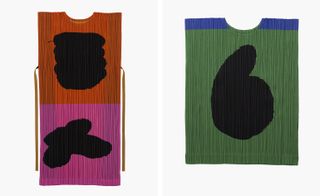
Once art, now clothing, Miyake revitalises Tanaka’s legacy in this new series of dresses, coats and bags

Miyake and Tanaka were acquainted and held each other’s work in high regard

Tanaka's tome, Variations of Bold Symbols (1992), offers a compilation of this graphic works, which directly inspired the collection
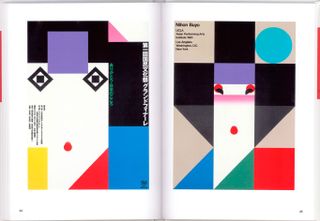
The pair met in the Sixties and maintained a close friendship until Tanaka’s death in 2002
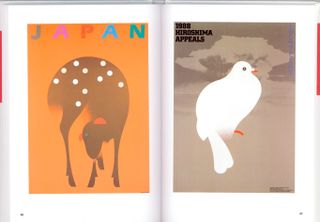
Launching just over a decade after his passing, Miyake’s reinterpretation of his work is a timely homage, from one Japanese icon to another
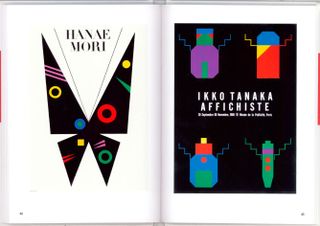
Tanaka’s deceptively simple oeuvre uses block colours and overlaid geometric forms to explore the boundaries of abstraction and realistic portraiture
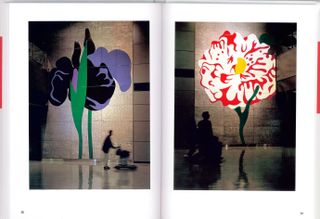
The book offers a mosaic of colour blocks adorned with hand-drawn symbols
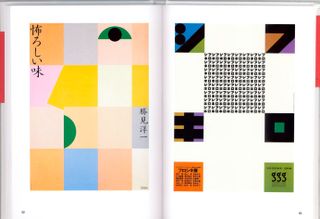
It vividly celebrates abstraction with bold graphic cues
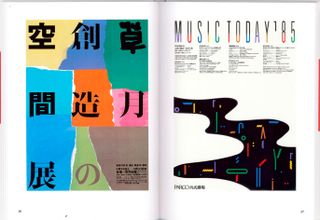
While Tanaka’s designs are now most commonly reproduced on posters or in books on Japanese art, Miyake’s creations seek to recontextualise his work, introducing the dynamism of the body to the vitality of the artist’s aesthetic
INFORMATION
The collection is available exclusively from Issey Miyake’s London ‘Pleats Please’ store and Harvey Nichols Knightsbridge from 18 February 2016. For more information, visit the website
Wallpaper* Newsletter
Receive our daily digest of inspiration, escapism and design stories from around the world direct to your inbox
-
 Gucci’s ‘Design Ancora’ reimagines furniture classics in rich red
Gucci’s ‘Design Ancora’ reimagines furniture classics in rich redGucci launches new editions of Italian design icons in an alluring deep red, showcased during Milan Design Week 2024
By Simon Mills Published
-
 Loewe’s Jonathan Anderson drafts artists to create 24 extraordinary lamps at Milan Design Week 2024
Loewe’s Jonathan Anderson drafts artists to create 24 extraordinary lamps at Milan Design Week 2024Loewe creative director Jonathan Anderson commissioned international artists and artisans to explore ‘illumination within the house’ with a series of lamps and lighting installations, shown at a group exhibition at Milan Design Week 2024
By Scarlett Conlon Published
-
 What are polynucleotides? Trying the skin injectable made from salmon sperm
What are polynucleotides? Trying the skin injectable made from salmon spermPolynucleotides are the latest in skin injectables, containing DNA derived from the gonads of salmon. Wallpaper* Beauty & Grooming Editor Hannah Tindle tries them to discover exactly how they work
By Hannah Tindle Published
-
 Kiko Kostadinov’s Tokyo outpost is a fashion store like no other
Kiko Kostadinov’s Tokyo outpost is a fashion store like no otherBulgaria-born designer Kiko Kostadinov tells Wallpaper* why he chose Tokyo to open his first store, which sets to ‘pervert the traditional mould’ and features collaborations with artists such as Ryan Trecartin
By Orla Brennan Published
-
 ’Issey Miyake: 1960 to 2022’ is a definitive guide to the pioneering Japanese designer
’Issey Miyake: 1960 to 2022’ is a definitive guide to the pioneering Japanese designer’Issey Miyake: 1960 to 2022’ is a new Taschen book that provides a comprehensive overview of the pioneering Japanese designer’s ’poetic but pragmatic’ work
By Jack Moss Published
-
 Issey Miyake’s radiant new Paris store celebrates its deep-rooted links to the city
Issey Miyake’s radiant new Paris store celebrates its deep-rooted links to the cityIssey Miyake’s new flagship store on Paris’ Rue François is designed by Tokujin Yoshioka, featuring a luminous orange wall designed to evoke the rising sun
By Jack Moss Published
-
 This season’s womenswear channels freedom and escape
This season’s womenswear channels freedom and escapeThese S/S 2024 womenswear looks promise an escape from the everyday, and are photographed amid the otherwordly landscapes of the Canary Islands for the March 2024 Style Issue of Wallpaper*
By Jack Moss Published
-
 Ya-man’s Tokyo store is ‘an immersive, almost psychedelic experience’
Ya-man’s Tokyo store is ‘an immersive, almost psychedelic experience’Ya-man, the Japanese beauty brand known for its tech-focused devices and gadgets, opens an otherworldly HQ in Ginza, Tokyo
By Daven Wu Published
-
 Designer Ronan Bouroullec on his colourful collaboration with Homme Plissé Issey Miyake
Designer Ronan Bouroullec on his colourful collaboration with Homme Plissé Issey MiyakeThe multidisciplinary French artist and designer saw his colour-soaked drawings reinterpreted by the Homme Plissé Issey Miyake design team as part of the Japanese brand’s menswear show in Paris last week
By Jack Moss Published
-
 Paris Fashion Week Men’s A/W 2024: Loewe to Hermès
Paris Fashion Week Men’s A/W 2024: Loewe to HermèsThe best of Paris Fashion Week Men’s A/W 2024 in our ongoing report, from Jonathan Anderson’s church of masculinity at Loewe to a consideration of pleasure from Véronique Nichanian at Hermès
By Jack Moss Last updated
-
 Year in review: top 10 beauty and grooming features of 2023, selected by Wallpaper’s Hannah Tindle
Year in review: top 10 beauty and grooming features of 2023, selected by Wallpaper’s Hannah TindleOur top 10 beauty and grooming features of 2023 span from Prada’s make-up debut to Japanese hair styling and the secrets of Björk’s nail artist
By Hannah Tindle Published